Reprinted with the author's permission, from her blog God is in the Dirt which we highly recommend; Sara Stratton's recent articles range from California to Newfoundland, the Appalachians in Ohio, and Toronto.
The Common Sense Sabbatical (3 Aug 2012)
The focus of my sabbatical is the land we inhabit. How does it shape us? How do we shape it? And what role does our faith (in my case, liberal Christian) have to do with it? I began this exploration with a week in California at the home of Elaine Enns and Ched Myers, otherwise known as the Bartimaeus Institute, in a course called “Rooting Faith: Theology and Practices of Bioregional Discipleship” — a time for us to reflect biblically and theologically on the land, and to learn more about permaculture.
As our permacuture specialist Chris Grataski noted, permaculture has about a million definitions. At heart, it is a form of agriculture that is based on mimicking naturally occurring ecosystems — so for example, rather than cycling the same annual crops in and out of the same piece of chemically enriched soil, you try to create an agricultural ecosystem that, through living and dying, is able to nourish and sustain itself. The more I heard Chris talk about permaculture, the more I remembered Indigenous agricultural traditions like the companion (or closely grouped) growing of the three sisters (beans, corn, and squash), wherein the beans fix nitrogen in the soil for the other crops, the corn provides a structure up which the beans can climb, and the squash forms a kind of living mulch, keeping the soil damp and preventing the growth of weeds. (It makes a pretty nice soup, too, by the way.)
The more Chris taught us — double-digging rather than mechanically tilling, building a garden bed by sheet mulching — the more I imagined my grandmothers working their mixed gardens in Safe Harbour in the 1920s or 30s, tilling the soil by hand, adding natural organic fertilizers (capelin!) and moving things around year to year. “Why, it’s like common sense!” I blurted out one afternoon, and that got one of Chris’s infrequent but large, generous, and thoughtful grins.

What exactly is a sheet mulch bed, you ask? Why, it’s when you take this dry patch
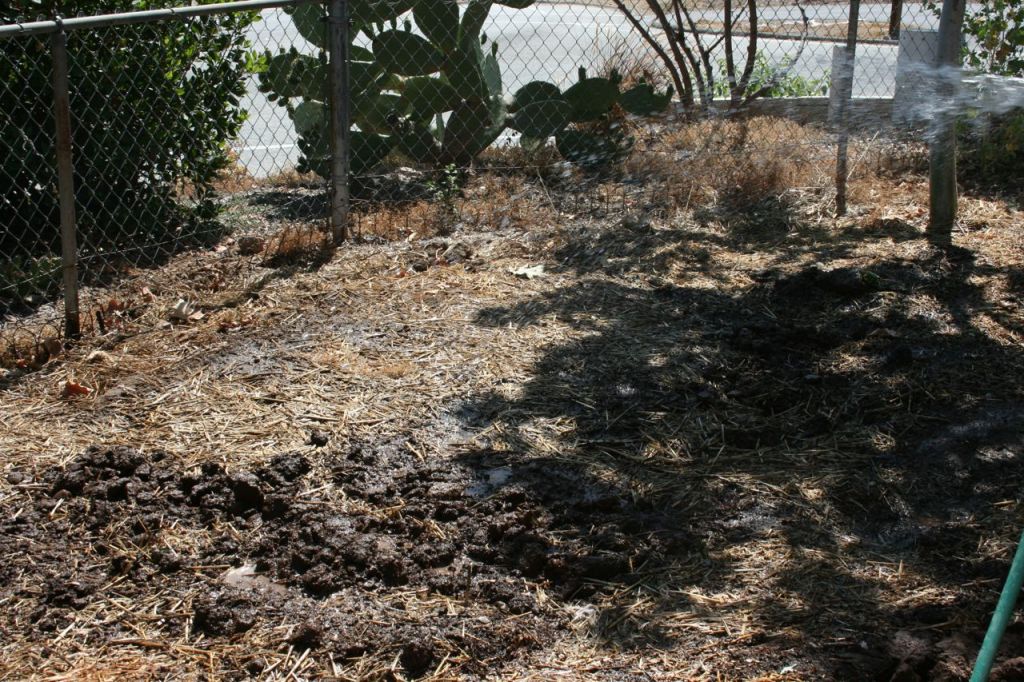
Add a layer of cardboard
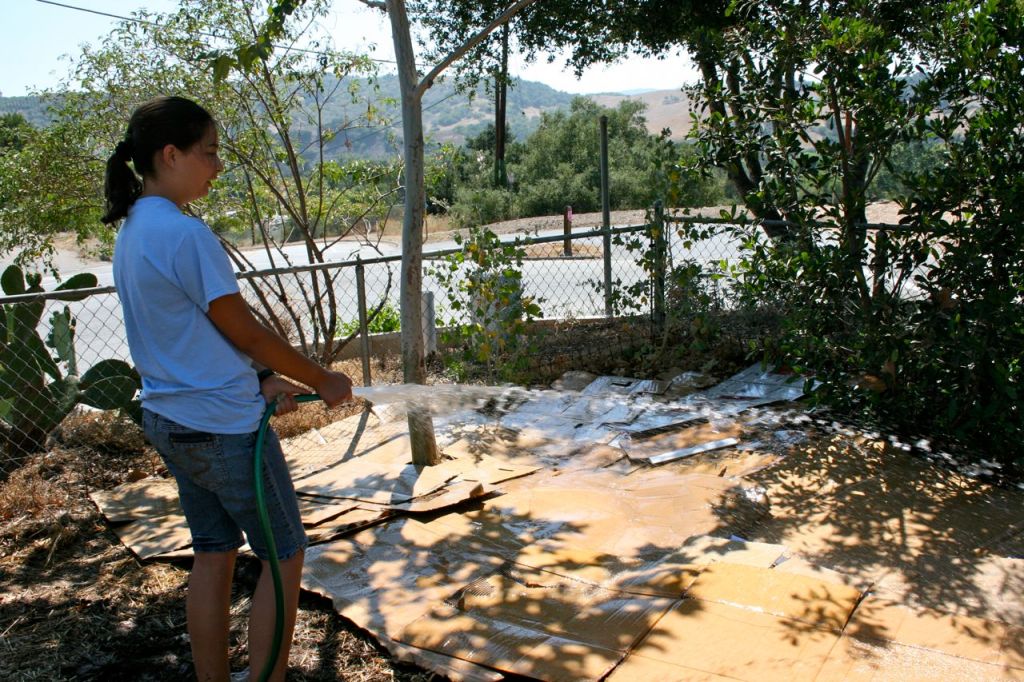
Then a thick layer of straw or hay — it can even be mouldy! This and some other dry brown garden waste mimic the older material you would find falling in a natural ecosystem such as a forest.

Then a layer of green waste — this mimics the newer material an ecosystem sheds.

A heavy layer of manure and compost — we all know what this mimics.

And then finally we have something into which we can plant

Elaine plants a Viburnum opulus, known as Kalyna in her ancestral home of Ukraine, where it has great cultural resonance, signifying both struggle and the rootedness of family. Also known as cramp bark, in folk medicine this plant was used by women all over the world to deal with menstrual and childbirth pain.
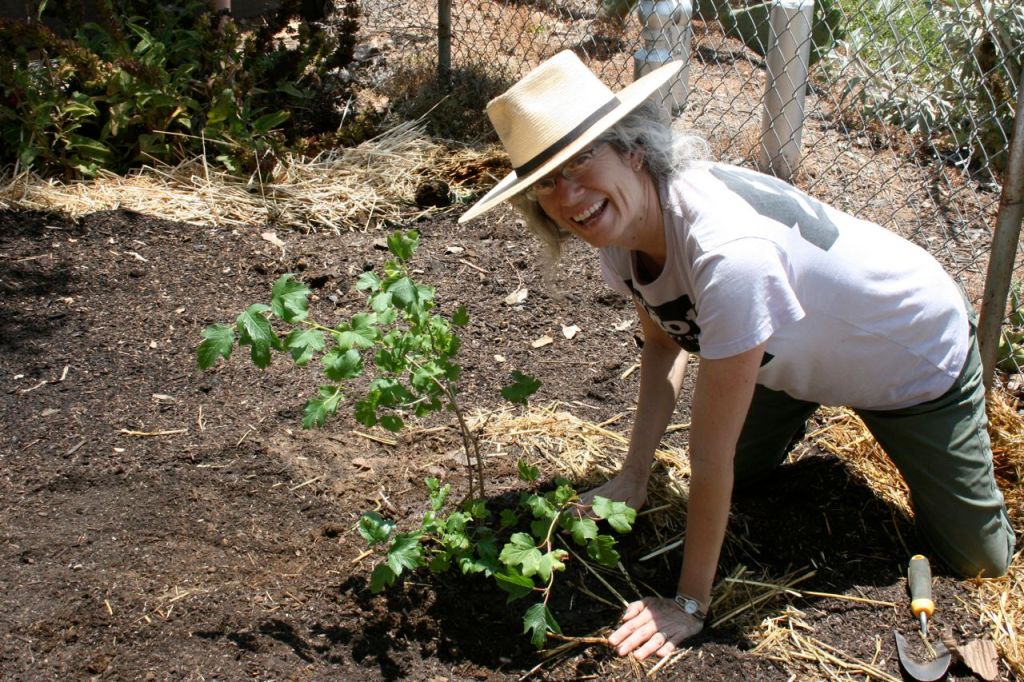
Building this garden, which took a couple of days on our part and even more of Chris’s and Elaine’s energy in the planning and gathering of raw materials, was hard work but it feels good to have been a part of something that will continue to grow, feeding itself and providing beauty and healing to all who seek it. The work of my hands, together with others’, is now a part of this place in the oak chaparral of Southern California.

But what we did there is a very small piece, as Wendell Berry reminds us in his foreword to theologian Ellen F. Davis’s Scripture, Culture, and Agriculture: An Agrarian Reading of the Bible.

And there were cacti everywhere — propagated by breaking off one fat pad and sticking it in the soil … up would come another cactus!

I found great beauty in what we observed on our first morning there, in the dry but still resinous sage whose scent we breathed in deeply, and in the lessons we drew from the Old Testament about humanity’s inability to further perfect what exists in nature. A phrase remains: “nothing we can make can mediate God more faithfully than what God has made.” But in reviewing my notes of that morning, I saw this scribbled down in a margin: “Western scrubjay. Northern mockingbird. Hummingbirds. Hawks. Vultures. Woodpeckers working lightpole. (Very active 10:15-10:40.)”
It was an acorn woodpecker and he spent the entire week excavating a series of utility poles. In so doing, he became to me the visual emblem of another phrase from our discussion: “We have grown up in landscapes that Creator did not make.” And, I might add, that nature herself has not relinquished to us, despite what we may think. Thank you, acorn woodpecker.
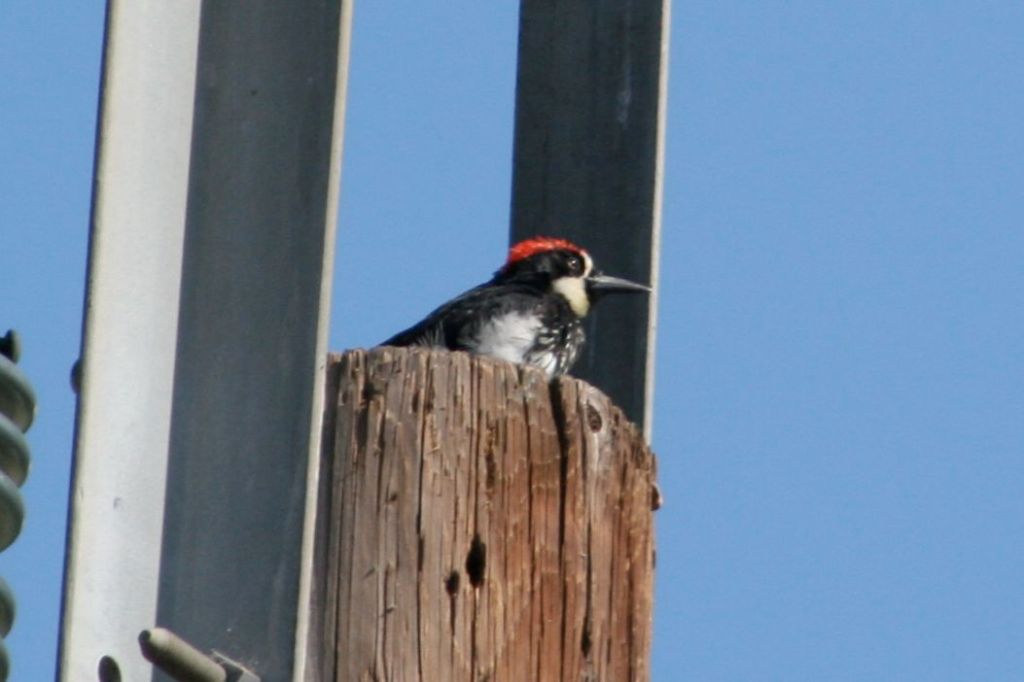
We also walked through Ched’s and Elaine’s place taking in the oak chapparal — a landscape that I had never heard of before this trip. Invoke “Mediterranean landscape,” though and it’s more familiar — hot, dry summers and scrubby, fragrant drought-resistant plants. Here I watched lark sparrows run through the scrub.

We sat in a dry riverbed (dry for a number of reasons: seasonal water flow, damming and diversion for drinking and recreation, global climate climate change):

A mockingbird sat nearby and sang his many tunes before our ambling flushed him:

And I watched turkey vultures tip-tip-tip overhead, looking down carefully at us.

Under huge, ancient California oaks, we talked about where we were, and while I engaged in this, I was also always just off to the side of everyone else, trying to determine who was with us.
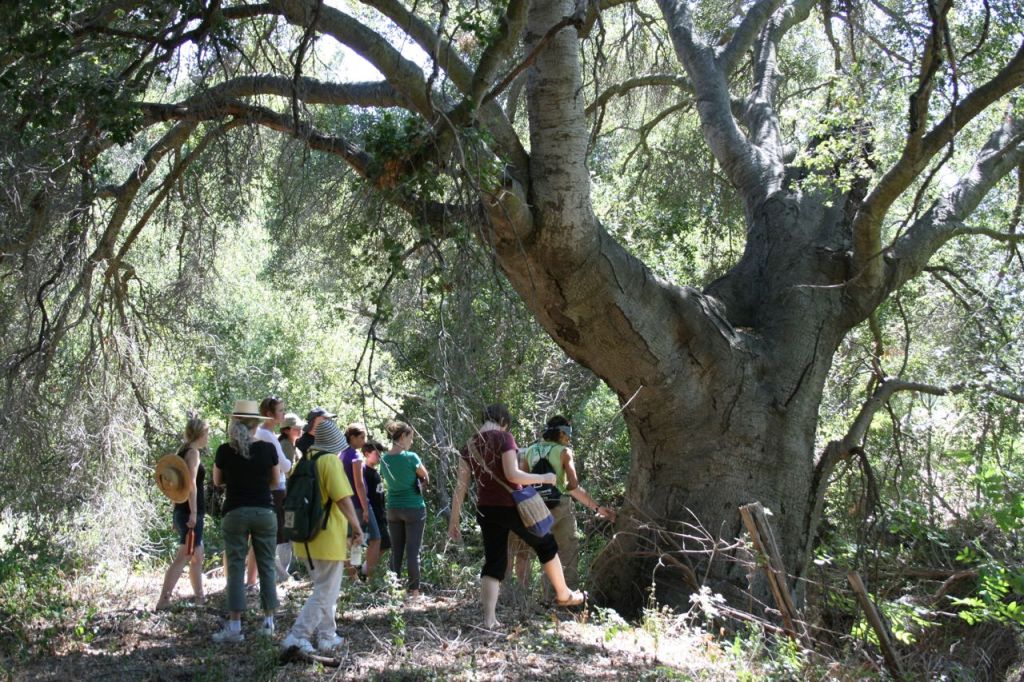
Another trip, this one to the 80 acres of Appalachian Ohio and the larger environs that Julie Zickefoose and Bill Thompson III define as their “place,” — and the neighbours were much more apparent. Julie’s and Bill’s effort to provide a place of refuge for wildlife (primarily but not exclusively birds) displaced by urbanization, large-scale farming, and the extraction of fossil fuels (oil and natural gas) has resulted in a rich biodiversity: as I write this, they’ve seen 187 avian species on their property (known as Indigo Hill for all the indigo buntings that live there) and the place is crawling with snakes, turtles and amphibians of all sorts.
This is one of the box turtles we met on one of our walks:
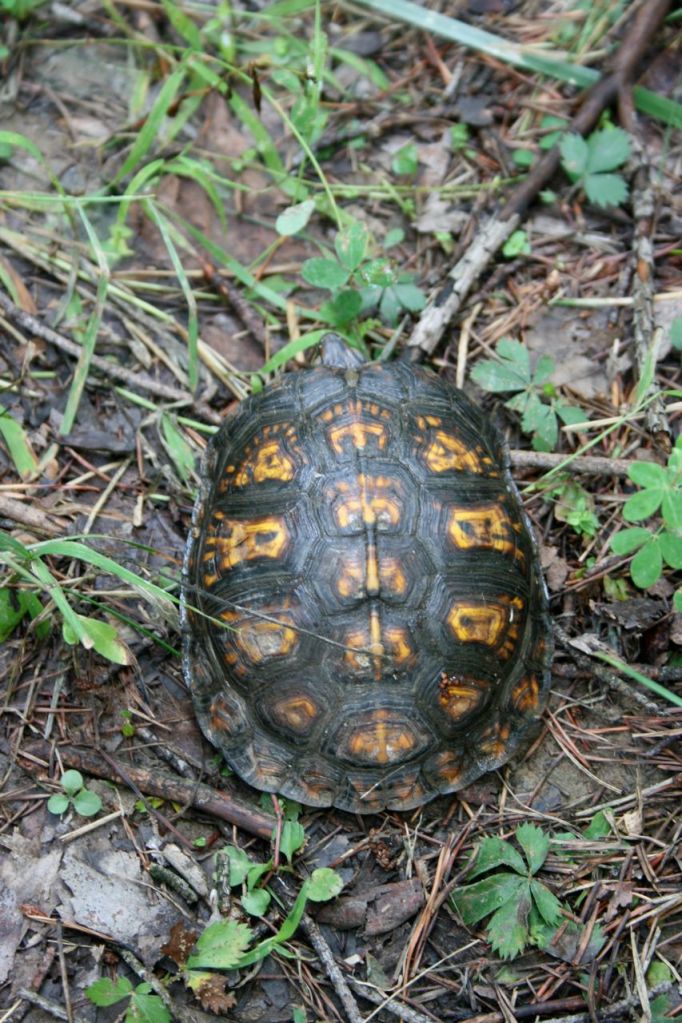
A very special box turtle, as it happens. Turns out it is Shelly, whom Julie rescued from urban Marietta, OH, when it was about the size of a slider (you know, the mini hamburgers). Three years later, Shelly was big enough to be released. And she was, in August 2011. And then in July 2012, she ambled right across our path. Much to the delight of her foster turtlemom.

You can read Julie’s account of Shelly’s early days, the moment we found her, and see Shelly in action on Julie’s blog.
Every day, we saw bluebirds. Here, my partner Kelly holds a bunch in her hands.

These little ones are here because Julie has built safe boxes in which bluebird parents can nest and raise a brood or two each summer. This was a good year — several pairs had three broods.The bluebirds are a great example of knowing your place and who lives there in the negative sense — while bluebirds have made a comeback, they have needed human help because humans have hurt them so much. Destroying habitat for farmland and cities, spraying pesticides that poison the food the parents gather, importing house sparrows from Europe that peck the life out of eggs and chicks — these human actions have all had a deleterious effect on the eastern bluebird. Julie’s nest boxes are a “bluebird trail,” part of an effort begun in the 1960s to provide safe heaven for these beautiful birds. Here Julie checks another nest to make sure it’s free of parasites now that the eggs are hatching.

Indigo Hill is also full of ruby-throated hummingbirds, drawn not just by sugar solution in feeders but also by thick plantings of cardinal flower and salvia. There’s a rule, tested by dedicated hummingbird watchers, that you count the maximum number of hummers you see using your food source, and you multiply that by 6 to get an accurate figure of how many there are. The highest we counted at one time on this trip was 12 — so 72 hummingbirds on this territory, sharing this place. Compared to past years, that’s a low number.

Walks in the broader environs brought other neighbours. This is a Green Frog, Rana clamitans:

A dogbane beetle.
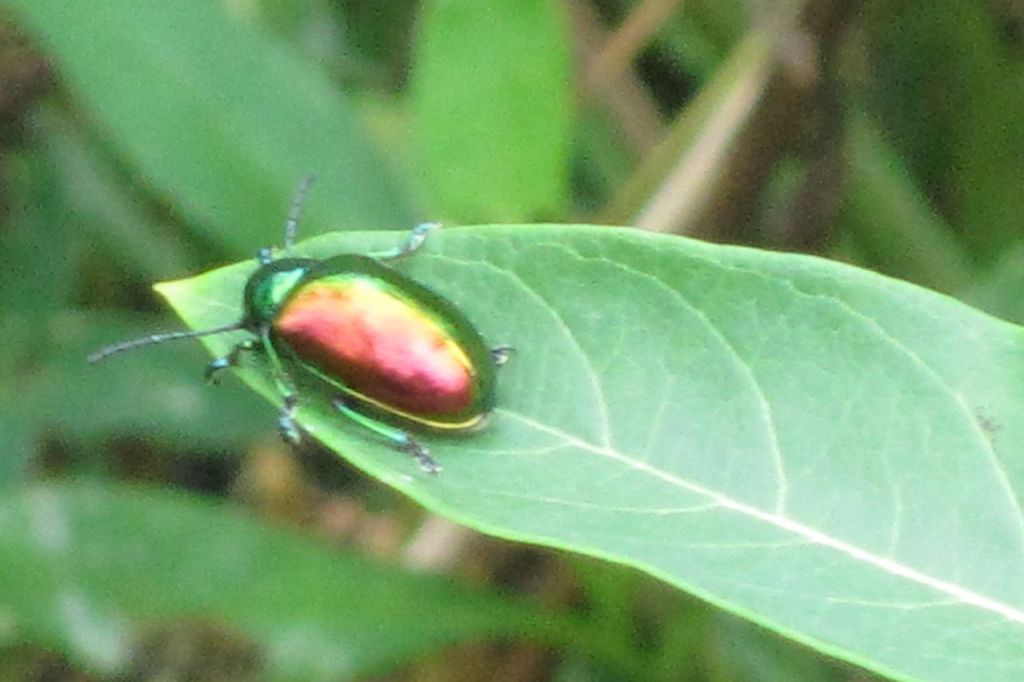
Butterflies, pooling on a country road to glean phosphorus. The yellow ones are eastern tiger swallowtails; the black ones are, I think, a mixture of female black morph eastern swallowtails and spicebush swallowtails. The difference is in the number and placement of orange spots, the quality of the blue, and the shape of the little tails on each wing.

This is the female black morph:

I have never seen so many butterflies: blues, sulphurs, skippers, hairstreaks, satyrs, and fritillaries. I’ll need to spend time poring over photos and guidebooks to determine just what I saw, but –this being her place– Julie knew them all at first glance. Well, almost all — she had to puzzle out a couple at home, because she thought she saw something new for the area, a county record. And in fact she had. She knows her place and what lives there with her. And it’s a far cry from the monarchs, cabbage whites, red admirals and eastern commas that I am used to in my own place!
What of my own place? I’ve defined it within this city of 2.5 million people as an area easily travelled within an hour on foot or with some streetcar assistance. It extends from my 30 x 100 foot urban lot to Toronto’s eastern beaches, the Leslie Spit, and the Glen Stewart and Taylor-Massey ravines. Squirrels, chipmunks, raccoons, beavers, coyote, rabbits, and red foxes all live here, as do garter snakes and eastern painted turtles. Butterflies, moths and insects. I have seen well over 100 species of birds here, including a snowy owl. We have counted 68 bird species in our backyard alone, everything from redbreasted nuthatch to scarlet tanager to redtailed hawk.
But a recent facebook exchange makes me wonder how well I know my place and those who share it with me. Seeking some wisdom on home improvements, I posted this update:

Do you, like Ched and Elaine, like Julie and Bill, like Kelly and me, have a practice of walking (or running, biking, or canoeing) around what you define as your place?
What do you see when you do?
Who do you see?
The Common Sense Sabbatical (3 Aug 2012)
The focus of my sabbatical is the land we inhabit. How does it shape us? How do we shape it? And what role does our faith (in my case, liberal Christian) have to do with it? I began this exploration with a week in California at the home of Elaine Enns and Ched Myers, otherwise known as the Bartimaeus Institute, in a course called “Rooting Faith: Theology and Practices of Bioregional Discipleship” — a time for us to reflect biblically and theologically on the land, and to learn more about permaculture.
As our permacuture specialist Chris Grataski noted, permaculture has about a million definitions. At heart, it is a form of agriculture that is based on mimicking naturally occurring ecosystems — so for example, rather than cycling the same annual crops in and out of the same piece of chemically enriched soil, you try to create an agricultural ecosystem that, through living and dying, is able to nourish and sustain itself. The more I heard Chris talk about permaculture, the more I remembered Indigenous agricultural traditions like the companion (or closely grouped) growing of the three sisters (beans, corn, and squash), wherein the beans fix nitrogen in the soil for the other crops, the corn provides a structure up which the beans can climb, and the squash forms a kind of living mulch, keeping the soil damp and preventing the growth of weeds. (It makes a pretty nice soup, too, by the way.)
The more Chris taught us — double-digging rather than mechanically tilling, building a garden bed by sheet mulching — the more I imagined my grandmothers working their mixed gardens in Safe Harbour in the 1920s or 30s, tilling the soil by hand, adding natural organic fertilizers (capelin!) and moving things around year to year. “Why, it’s like common sense!” I blurted out one afternoon, and that got one of Chris’s infrequent but large, generous, and thoughtful grins.

What exactly is a sheet mulch bed, you ask? Why, it’s when you take this dry patch

Add a layer of cardboard

Then a thick layer of straw or hay — it can even be mouldy! This and some other dry brown garden waste mimic the older material you would find falling in a natural ecosystem such as a forest.

Then a layer of green waste — this mimics the newer material an ecosystem sheds.

A heavy layer of manure and compost — we all know what this mimics.

And then finally we have something into which we can plant

Elaine plants a Viburnum opulus, known as Kalyna in her ancestral home of Ukraine, where it has great cultural resonance, signifying both struggle and the rootedness of family. Also known as cramp bark, in folk medicine this plant was used by women all over the world to deal with menstrual and childbirth pain.

Building this garden, which took a couple of days on our part and even more of Chris’s and Elaine’s energy in the planning and gathering of raw materials, was hard work but it feels good to have been a part of something that will continue to grow, feeding itself and providing beauty and healing to all who seek it. The work of my hands, together with others’, is now a part of this place in the oak chaparral of Southern California.

But what we did there is a very small piece, as Wendell Berry reminds us in his foreword to theologian Ellen F. Davis’s Scripture, Culture, and Agriculture: An Agrarian Reading of the Bible.
We have been given the earth to live, not on but with and from, and only on the condition that we care properly for it. We did not make it, and we know little about it. In fact we don’t, and will never, know enough about it to make our survival sure or our lives carefree. Our relation to our land will always remain, to a significant extent, mysterious. Therefore, our use of it must be determined more by reverence and humility, by local memory and affection, than by the knowledge that we now call “objective” or “scientific.” Above all, we must not damage it permanently or compromise its natural means of sustaining itself. The best farmers have always accepted this …
Getting to Know the Neighbours (12 August 2012)
Part of getting to know your “place” is getting to know who shares it with you. You can really only do this by getting out in the open and seeing what’s out there. I’ve been doing this for a few years now in the backyard and larger neighbourhood of my east end Toronto home. Admittedly, it’s a great way to relax, but it’s also becoming for me a kind of spiritual practice. The American poet and environmentalist Gary Snyder talks about it in his book The Practice of the Wild:The pathless world of wild nature is a surprising school and those who have lived through her can be tough and funny teachers. Out here one is in constant engagement with countless plants and animals. To be well educated is to have learned the songs, proverbs, stories, sayings, myths (and technologies) that come with this experiencing of the nonhuman members of the local ecological community. Practice in the field, “open country,” is foremost. Walking is the great adventure, the first meditation, a practice of heartiness and soul primary to humankind. Walking is the exact balance of spirit and humility.The institute that I attended this summer, “Rooting Faith: Theology and Practices of Bioregional Discipleship,” was hosted by Ched Myers and Elaine Enns, who define their “place” as a semi-rural garden and the Southern Californian watershed in which it is situated. They moved there from Los Angeles (where Elaine had moved from Saskatchewan!) a few years ago, and part of the program was accompanying them as they learned more about their place. In the process of becoming a permacuture site, their garden was fragrant with sage, and full of produce like tomatilloes, oranges, and peaches. A Brazilian pepper tree just outside their fence spilled its spicy seeds over the ground.

And there were cacti everywhere — propagated by breaking off one fat pad and sticking it in the soil … up would come another cactus!

I found great beauty in what we observed on our first morning there, in the dry but still resinous sage whose scent we breathed in deeply, and in the lessons we drew from the Old Testament about humanity’s inability to further perfect what exists in nature. A phrase remains: “nothing we can make can mediate God more faithfully than what God has made.” But in reviewing my notes of that morning, I saw this scribbled down in a margin: “Western scrubjay. Northern mockingbird. Hummingbirds. Hawks. Vultures. Woodpeckers working lightpole. (Very active 10:15-10:40.)”
It was an acorn woodpecker and he spent the entire week excavating a series of utility poles. In so doing, he became to me the visual emblem of another phrase from our discussion: “We have grown up in landscapes that Creator did not make.” And, I might add, that nature herself has not relinquished to us, despite what we may think. Thank you, acorn woodpecker.

We also walked through Ched’s and Elaine’s place taking in the oak chapparal — a landscape that I had never heard of before this trip. Invoke “Mediterranean landscape,” though and it’s more familiar — hot, dry summers and scrubby, fragrant drought-resistant plants. Here I watched lark sparrows run through the scrub.

We sat in a dry riverbed (dry for a number of reasons: seasonal water flow, damming and diversion for drinking and recreation, global climate climate change):

A mockingbird sat nearby and sang his many tunes before our ambling flushed him:

And I watched turkey vultures tip-tip-tip overhead, looking down carefully at us.

Under huge, ancient California oaks, we talked about where we were, and while I engaged in this, I was also always just off to the side of everyone else, trying to determine who was with us.

Another trip, this one to the 80 acres of Appalachian Ohio and the larger environs that Julie Zickefoose and Bill Thompson III define as their “place,” — and the neighbours were much more apparent. Julie’s and Bill’s effort to provide a place of refuge for wildlife (primarily but not exclusively birds) displaced by urbanization, large-scale farming, and the extraction of fossil fuels (oil and natural gas) has resulted in a rich biodiversity: as I write this, they’ve seen 187 avian species on their property (known as Indigo Hill for all the indigo buntings that live there) and the place is crawling with snakes, turtles and amphibians of all sorts.
This is one of the box turtles we met on one of our walks:

A very special box turtle, as it happens. Turns out it is Shelly, whom Julie rescued from urban Marietta, OH, when it was about the size of a slider (you know, the mini hamburgers). Three years later, Shelly was big enough to be released. And she was, in August 2011. And then in July 2012, she ambled right across our path. Much to the delight of her foster turtlemom.

You can read Julie’s account of Shelly’s early days, the moment we found her, and see Shelly in action on Julie’s blog.
Every day, we saw bluebirds. Here, my partner Kelly holds a bunch in her hands.

These little ones are here because Julie has built safe boxes in which bluebird parents can nest and raise a brood or two each summer. This was a good year — several pairs had three broods.The bluebirds are a great example of knowing your place and who lives there in the negative sense — while bluebirds have made a comeback, they have needed human help because humans have hurt them so much. Destroying habitat for farmland and cities, spraying pesticides that poison the food the parents gather, importing house sparrows from Europe that peck the life out of eggs and chicks — these human actions have all had a deleterious effect on the eastern bluebird. Julie’s nest boxes are a “bluebird trail,” part of an effort begun in the 1960s to provide safe heaven for these beautiful birds. Here Julie checks another nest to make sure it’s free of parasites now that the eggs are hatching.

Indigo Hill is also full of ruby-throated hummingbirds, drawn not just by sugar solution in feeders but also by thick plantings of cardinal flower and salvia. There’s a rule, tested by dedicated hummingbird watchers, that you count the maximum number of hummers you see using your food source, and you multiply that by 6 to get an accurate figure of how many there are. The highest we counted at one time on this trip was 12 — so 72 hummingbirds on this territory, sharing this place. Compared to past years, that’s a low number.

Walks in the broader environs brought other neighbours. This is a Green Frog, Rana clamitans:

A dogbane beetle.

Butterflies, pooling on a country road to glean phosphorus. The yellow ones are eastern tiger swallowtails; the black ones are, I think, a mixture of female black morph eastern swallowtails and spicebush swallowtails. The difference is in the number and placement of orange spots, the quality of the blue, and the shape of the little tails on each wing.

This is the female black morph:

I have never seen so many butterflies: blues, sulphurs, skippers, hairstreaks, satyrs, and fritillaries. I’ll need to spend time poring over photos and guidebooks to determine just what I saw, but –this being her place– Julie knew them all at first glance. Well, almost all — she had to puzzle out a couple at home, because she thought she saw something new for the area, a county record. And in fact she had. She knows her place and what lives there with her. And it’s a far cry from the monarchs, cabbage whites, red admirals and eastern commas that I am used to in my own place!
What of my own place? I’ve defined it within this city of 2.5 million people as an area easily travelled within an hour on foot or with some streetcar assistance. It extends from my 30 x 100 foot urban lot to Toronto’s eastern beaches, the Leslie Spit, and the Glen Stewart and Taylor-Massey ravines. Squirrels, chipmunks, raccoons, beavers, coyote, rabbits, and red foxes all live here, as do garter snakes and eastern painted turtles. Butterflies, moths and insects. I have seen well over 100 species of birds here, including a snowy owl. We have counted 68 bird species in our backyard alone, everything from redbreasted nuthatch to scarlet tanager to redtailed hawk.
But a recent facebook exchange makes me wonder how well I know my place and those who share it with me. Seeking some wisdom on home improvements, I posted this update:
We are planning to replace our roof this year. We live in a bungalow in a raccoon-intensive neighbourhood and so animal damage and break-in are not uncommon (though so far we’ve only had damage, not squatters!). We’re therefore considering a metal roof and are seeking opinions from those of you who may have them.My friend Richard, a United Church minister in the neighbourhood, replied that he couldn’t help but read the post from the raccoon’s point of view, wondering what it must feel like to live in such a “human-intensive neighbourhood.”

Do you, like Ched and Elaine, like Julie and Bill, like Kelly and me, have a practice of walking (or running, biking, or canoeing) around what you define as your place?
What do you see when you do?
Who do you see?


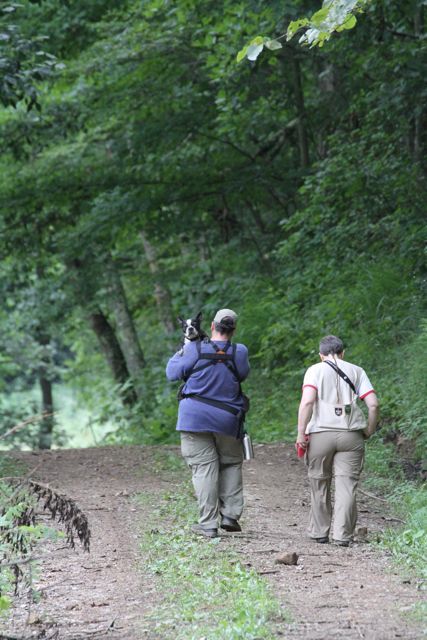
No comments:
Post a Comment